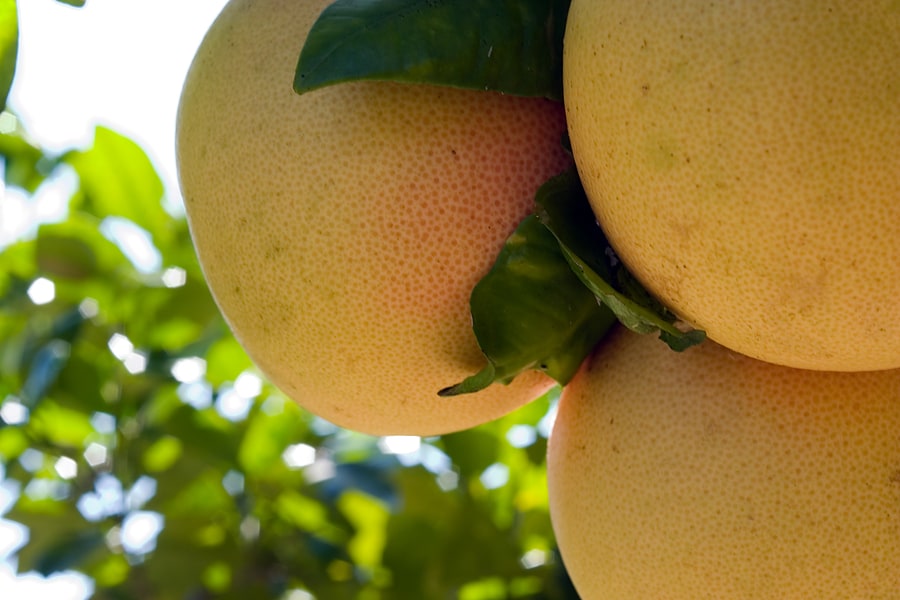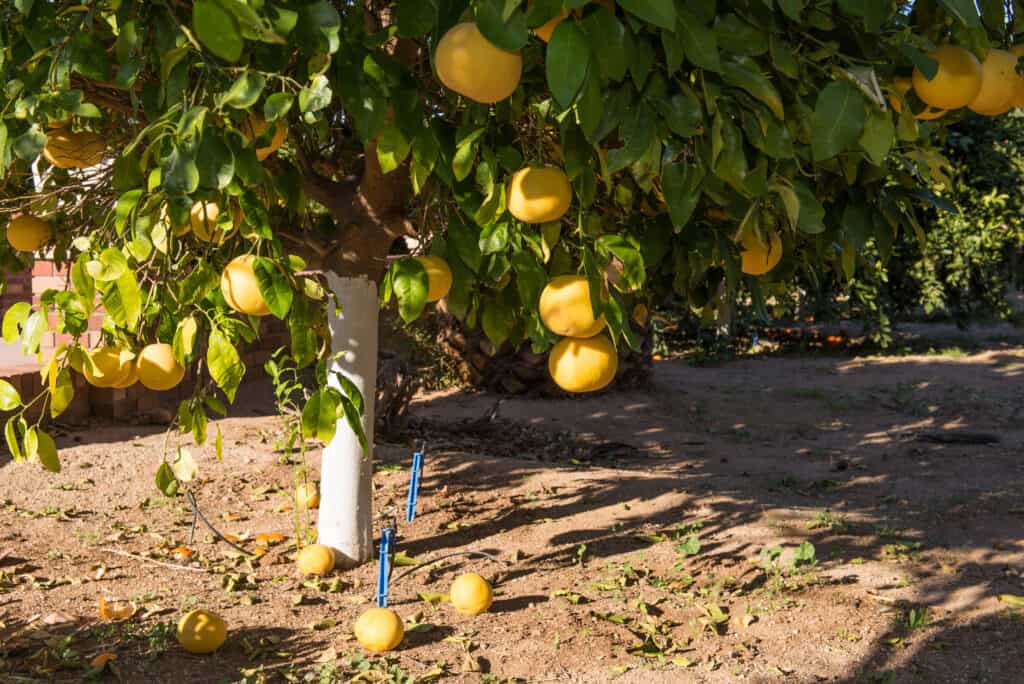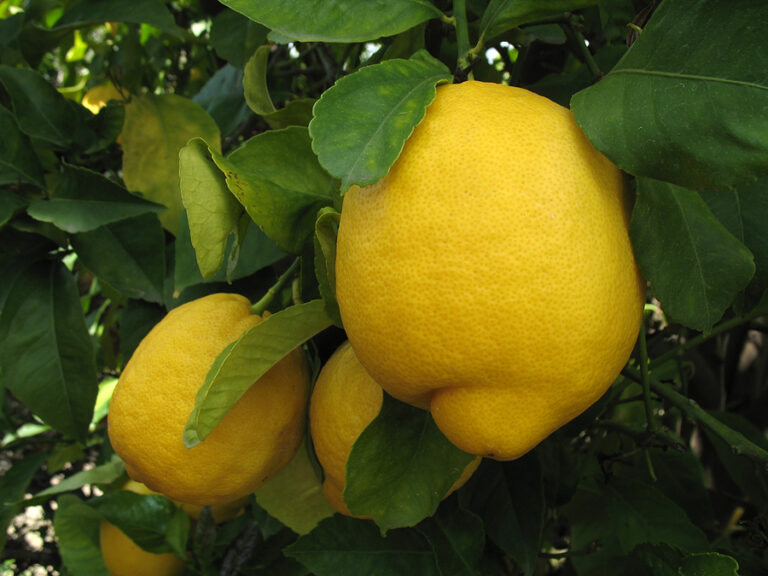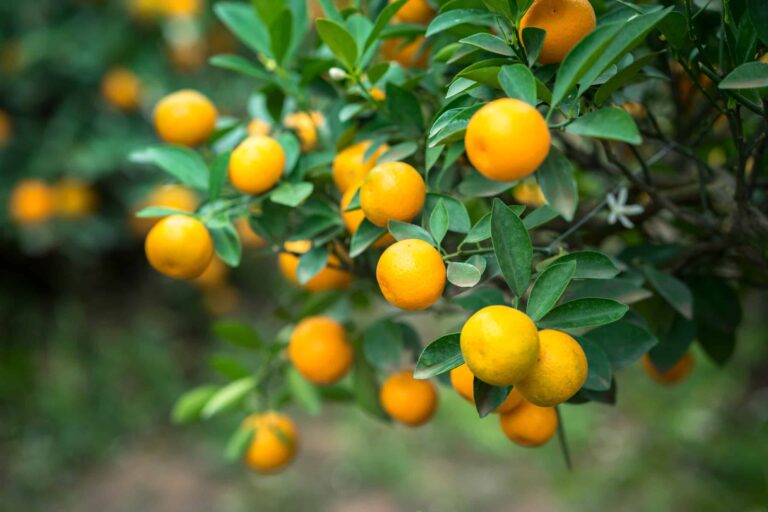How to Grow Grapefruit Trees in the Home Garden
Tangy grapefruit can be eaten raw—by the half or peeled and sectioned, it can be added to green and fruit salads and compotes, and it can be juiced.
Grapefruits require heat to develop their sweet-tart flavor. A grapefruit that feels heavy for its size is ripe and ready to eat or juice.
Grapefruits are best grown where summer days are hot and nights are warm and where humidity is above 60 percent; grapefruits, which can require up to a year or more to ripen, also require sunny winter days and cool, not cold, nights. Most of Florida and many parts of Texas are ideal grapefruit-growing regions. Grapefruits will grow in relatively drier regions including California and Arizona but the flavor may not be as rich.
Related articles:
- Ways to Serve Oranges
- Ways to Serve Mandarin Orange
- Ways to Serve Lemons
- Ways to Serve Grapefruit
- Ways to Use Limes

Grapefruits take six months to a year to ripen in hot, humid climates; in relatively cooler regions, grapefruits can take 14 months and even as long as 18 months to ripen. It is not uncommon for a grapefruit tree to have two crops ripening on the tree at the same time.
To increase the sweetness of grapefruits, plant trees in very warm locations. Southern exposure in front of a wall that will reflect heat is a good planting spot in most home gardens. Let fruit hang on the tree and soak up the sun for as long as possible, up to 18 months to ensure sweetness.
Where the climate is not ideal for grapefruit growing, grapefruit-pummelo hybrids can be grown instead. These thick-skinned hybrids require less heat but will taste the same as most ripe grapefruits.
See also How to Grow Citrus
Grapefruit history
The grapefruit is a relatively new citrus species. It is probably a natural hybrid between pummelo and orange. It is sometimes confused with the pummelo. The grapefruit is probably native to the Wet Indies. It became known as the grapefruit when it was introduced to Europe.
The botanical name for the grapefruit and oro blanco is Citrus x paradisi. The botanical name for the pomelo Citrus grandis.
Grapefruit, pomelo, and oro blanco
The grapefruit, pomelo, and oro blanco are large subtropical citrus fruits that are most juicy and range from refreshingly tart to spicy sweet. Each is good for eating fresh, squeezing into juice, or adding to salads.
The grapefruit is tart and tangy with an underlying sweetness. The oro blanco is sweet, sometimes described as a grapefruit with sugar already added. The pomelo falls in between, sometimes spicy-sweet, sometimes tangy and tart.
Pomelos are an ancient fruit, grown in Asia for more than 4,000 years. The grapefruit is a cross between a pomelo and an orange, first named by a French botanist in 1820. Oro blanco is grapefruit and pomelo cross, a California cultivar introduced in 1958.
The pomelo and oro blanco can be used anywhere a grapefruit is suggested.
The grapefruit is round, between 4 and 6 inches in diameter, with very smooth, thin skin that ranges from completely yellow to yellow with a pinkish hue. The flesh of the grapefruit ranges in color from white to pale pink to ruby red.
The oro blanco is just slightly larger than the grapefruit with a smooth, thick rind that can be green, yellow, or pink. The oro blanco’s flesh is juicy and golden yellow.
The pomelo is the largest of the three, up to 12 inches in diameter, usually spherical or pear-shaped with a very thick smooth to rough skin that can be green, yellow, or pink. The flesh of the pomelo is semi-transparent white, pink, or very deep pink and not as juicy as a grapefruit or oro blanco.
The pomelo, grapefruit, and oro blanco require prolonged periods of high temperature to achieve their maximum flavor and sweetness. The pomelo is the most tropical of all citrus and grows best in tropical regions. Grapefruit and oro blanco should be grown in frost-free climates. The pomelo tree grows to about 20 feet tall, and the grapefruit and oro blanco to about 30 feet tall. In the warmest climates, these fruits can ripen in as little as six months. Grown in sub-tropical and temperate zones, the grapefruit and oro blanco can take a year or even 18 months to ripen.
Grapefruit grown in low-humidity desert regions will have blemish-free but thick peels and acidic flavor. Grapefruit grown in tropical climates will have thin but slightly blemished skins and a sweet flavor.
Grapefruits in general are dived into natural types: there are common white or yellow-fleshed grapefruits, and there are pigmented or pale pink to ruby red grapefruits. ‘Marsh’ is the most famous white-fleshed grapefruit cultivar. ‘Ruby’, ‘Star Ruby’, and ‘Flame’ are the best-known red-pigmented grapefruits.
Grapefruits can be seeded or seedless. Seeded grapefruits tend to be more flavorful than seedless.
The grapefruit takes its name from the French word for “clusters” which is grappes. Grapefruits grow in grapelike clusters. Oro blanco in Spanish means “white gold”, the color of the oro blanco’s flesh. The pomelo most likely takes its name from the French word for ‘apple’, pomme. The pomelo was first called by the name pome-citron, meaning ‘apple-citrus’ in French.
Grapefruit growing quick tips
Here are a few things to know about growing grapefruits:
- Grapefruits grow best in USDA Zones 9 and 10; protect trees if temperatures fall into the 30sF.
- Some grapefruit trees grow 15 feet tall, others can grow to 30 feet tall; check the height at maturity of the variety you want to grow.
- Some grapefruits have more seeds than others; seedy fruits have richer flavor and separate into segments more easily than fruits with few or no seeds.
- Red, pink, and white-fleshed grapefruits have the same flavor; one is not sweeter than the other. (The flesh of so-called white grapefruits is actually pale yellow or rosy.)
- The red pigmentation of red-fleshed varieties develops where summers are long and very hot; where summers are cool, the flesh of red grapefruit may appear light pink or white.
- A heavy grapefruit indicates a high percentage of juice and thin skin.
- Once ripe, most grapefruits can hang on the tree for several months without deteriorating.
Best climate to grow grapefruit trees
Grapefruit need a warmer climate than many citrus species; they grow best in a subtropical climate unless extra winter protection can be given. Grapefruit will only tolerate light frosts.
Grapefruit trees are resistant to heat and to drying winds. The grapefruit can tolerate cold as well as the orange. Grapefruit grows best in hot desert valleys.
Grapefruits need at least nine to ten months to mature on the tree.
Grapefruit is more acidic in cooler areas. Protect grapefruit from frost at 26°F.
Where to plant a grapefruit tree
- Plant grapefruit trees in any warm, sunny spot sheltered from the wind.
- Grapefruit prefers acid soil with a pH of 5.0 to 6.5, but it will grow at 7.0.
- Choose the warmest spot in the garden; allow enough room for the tree to grow to its mature size. A standard-size tree will need 20 to 25 feet tall and wide.
- Grapefruit feeder roots occur in the top 3 feet of soil; taproots can extend to 17 feet or more. The upper part of the soil should be enriched with aged compost.
- Roots will extend beyond the tree dripline so choose a place where neighboring roots will not interfere with growth.
- If planting in a lawn remove a 3- to 5-foot circle of lawn to eliminate competition from grass roots.
- Vetch, clover, and hairy indigo can be used as cover crops to increase the soil’s organic content.
When to plant a grapefruit tree
- Planting time should allow for the longest period of mild or warm weather before extreme hot or cold temperatures; this will allow the plant to become established.
- In freeze-prone areas, plant in late winter or early spring after all danger of frost is past. In hot summer regions, plant in the fall; this will allow the tree to become established before very hot weather.
- Plant in autumn in normally frost-free regions.
How to plant a grapefruit tree
- Dig a hole deeper than the root ball and twice as wide. Rough up the sides of the hole to let the roots grow out more easily.
- Do not amend the backfill or add fertilizer to the bottom of the hole; feed the tree only when it starts to produce new growth.
- Carefully lift the tree from its container; avoid jerking the tree from the container.
- Straighten out any circling roots; cut away broken roots.
- Plant the tree at the same level or slightly higher as it grew in the container; the color of the trunk will tell you where the previous soil level was.
- Pack soil gently around the root ball eliminating air pockets.
- When the hole is half full, fill it with water to settle the soil. Once the water has soaked in, finish packing the soil to the top of the hole and water again.
- Create a watering basin around the newly planted tree; use garden soil to about 6 inches high and wide; you can form an inner wall – creating a donut shape – to keep water away from the trunk.
- Spacing
Grapefruit tree spacing
- Plant grapefruit trees about 15 feet apart. A grapefruit tree can grow to 30 feet tall and half or more as wide.
Grapefruit tree pollination and flowering
- Grapefruit are pollinated by bees and other insects. The flowers are self-fertile and have a good fruit set. You need only one tree to set fruit.
- Creamy-white flowers are borne singly or in clusters. Flowers appear from spring through summer. Fruits take 6 to 8 months to ripen after fruit set.
Planting a grapefruit tree in a container
- Both standard and dwarf grapefruit trees can be grown in containers. Because roots will be restricted in a container, the plant will grow smaller than it would in the ground.
- A container at least 18 inches across should be sufficient for several years.
- Make sure the container has drainage holes. Keep in mind, that moisture evaporates faster from porous pots than nonporous ones, necessitating more frequent watering.
- A wheeled base such as a dolly will make it easier to move the plant to protection during cold weather.
- Plant in light, well-drained potting mix. Do not mix fertilizer into the soil.
- Set the plant at the level it grew in the original pot.
- Allow e or 3 inches at the top of the container for water.
- Firm the soil around the root ball and then water thoroughly.
Grapefruit container culture – indoor growing
- Keep the soil evenly moist for potted trees. Use a moisture meter or test the soil with your finger whenever the soil feels dry.
- Water potted trees by pouring over the soil until water flows out the drainage holes.
- Don’t let the plant sit in a saucer full of water.
- Because container plants are watered so often. Fertilizer may be washed away quickly. Use a slow-release fertilizer that will not wash away with each watering.
- Move potted citrus indoors if a freeze is predicted.
- Grapefruit grown indoors needs bright light. Place the plant near a sunny window but away from radiators or heat sources.
- Sudden changes in temperature can result in leaf and fruit drop.
- The ideal humidity level for indoor citrus is about 50 percent. Overly dry air can result in leaf drop.
Watering a grapefruit tree
- The grapefruit tree is evergreen and needs water throughout the year.
- Water to keep the soil moist, but not wet.
- Water when the top few inches of soil are dry; use a moisture meter to determine how moist the soil is.
- Water the root system but keep the trunk and bud union dry.
- Deliver water to the roots by flooding a basin above the tree root zone or use drip irrigation. Irrigation should wet the entire root zone. Expand the watering area as the tree grows.
Feeding a grapefruit tree
- Feed the grapefruit tree with a citrus food high in nitrogen such as 10-5-10.
- A slow-release organic fertilizer will feed the plant throughout the year.
- Always follow package instructions on the amount and frequency of feeding.
- Feed grapefruit trees after they put on new growth.
- A nitrogen deficiency can result in leaves turning yellow; apply a high-nitrogen fertilizer.
- A zinc deficiency can result in abnormally small leaves with yellow blotches between the veins; this can occur in alkaline soils. Treat the tree with a foliar spray.
- An iron deficiency can result in young leaves gradually turning yellow between the veins. This can occur in alkaline soils that are poorly drained. Add a chelated iron to the soil.
- A manganese deficiency can occur along with a zinc or iron deficiency; young leaves turn a light green between the veins. Apply a foliar spray.
- A magnesium deficiency can cause older leaves to turn yellow between the veins. Apply a foliar spray or add magnesium sulfate to the soil.
Grapefruit tree routine care – weeding, mulching
- Mulch around the grapefruit tree to eliminate weeds that compete for water and nutrients.
- Mulch will keep roots cool and conserve soil moisture in hot weather. Remove mulch if a freeze is forecast; bare soil absorbs more warmth than mulch.
- Compost and leaf mold are suitable organic mulches.
- Keep mulch back from the tree trunk by about a foot to discourage rot.
Thinning and pruning a grapefruit tree
- Prune grapefruit only when necessary. Grapefruit trees flower and fruit on new growth; removing new growth reduces the harvest.
- Allow branches to grow close to the ground in intensely sunny regions. The low growth will protect the bottom branches from sunburn and give a bigger harvest.
- In humid regions, trim up lower branches to improve air circulation and deter diseases.
- In freeze-prone areas, avoid pruning in fall or winter; pruning can stimulate new growth that can be damaged by cold.
- Snip off suckers (rootstock growth) below the bud union on the trunk or underground. Root suckers will not bear the same fruit as the scion above the bud union.
- Remove watersprouts—upright growing shoots that appear on branches or in branch crotches. Lateral buds can develop on lateral branches; this can result new growth that will fill the interior of the tree; it’s best to remove this growth.
- Remove growth that makes the tree lopsided.
- Prune away dead or broken branches.
- Remove dead wood and unproductive twigs and stems; this will allow light and air into the center of the tree.
- Remove the upper limbs if the tree grows too tall.
- On alternate bearing trees that produce a big crop one year and a light crop, the next remove some of the fruitlets on a heavy crop year.
Grapefruit pest controls
- Control ants with a sticky band on the trunk or use soap spray or ant baits.
- Remove aphids with a strong jet of water or apply soap or oil sprays.
- Remove mealybug cottony masses by hand or hose them off with water or apply soap or oil sprays.
- Mites can attack citrus that is underwatered.
- Scale insects can be suffocated with an oil spray.
- Handpick, trap, or bait slugs and snails.
Grapefruit disease controls
- Black rot and fungal diseases caused by rainy weather can be prevented if copper fungicides are applied early enough.
- Greasy spot fungal disease can occur in hot, humid climates; spray the tree with a oil or copper fungicide.
- Fruit brown rot can occur if fungal Phytophthora spores splash on the lower part of the tree; this can cause brown spots on the rind. Prune to improve air circulation.
- Foot rot or gummosis is caused by a Phytophthora infection; sap oozes from cracks. A systemic fungicide may treat the disease.
- Sooty mold feeds on the excrement of aphids and mealybugs; hose off sap suckers
Grapefruit environmental problems
- Trees that are alternate bearing can be thinned in heavy fruit crop years.
- Flower and fruit drop can occur if the tree has more flowers or fruit than it can support.
- Fruit splitting can occur if watering is irregular.
- Regreening can occur if ripe fruit remains on the tree during hot weather.
- Sports—leaves or fruit of a different color or shape—can occur occasionally.
- Cold damage can cause leaves and twigs to appear watersoaked. Remove damaged wood and fruit when temperatures moderate.
- Excessive fruit drop can be caused by sudden changes in temperature.
- Sunburn of stems and branches can occur in hot-sun areas; wrap the trunk with paper or cardboard bands.
- Wind damage can occur if trees are not protected from hot, drying winds.
Grapefruit propagation
- Grapefruit can be grown from seeds or cuttings. Seedlings will be clones of the parents.
- Sow seeds in early spring.
- Semi-ripe cuttings can be rooted in summer in well-drained compost.
- Grapefruit is more difficult to root from cuttings than lemons or limes, but easier than mandarins.
How to harvest grapefruit
- Grapefruit ripens only on the tree, not after being picked.
- Grapefruit can be left on the tree for storage in dry areas; this is recommended for home growers.
- Ripeness is not always reflected in rind color; the best way to tell if citrus is ripe is to pick a sample and try it.
- Fruit will hold on the tree and can be picked as you need it.
- Harvest the entire crop if a freeze is predicted; put the crop in cool storage.
- Harvest citrus by giving it a quick twist as you pull it or by clipping the stem with a hand pruner. Pulling fruit from the tree can result in broken branches or fruit that leaves some rind behind on the stem.
Storing grapefruit
- Ripe citrus will keep on the tree.
- Place ripe harvested citrus in cool storage.
Grapefruit in the kitchen
The grapefruit and oro blanco are most often eaten fresh, either halved or segmented. Either can be sprinkled with brown sugar and broiled. Pomelo sections can be used to make fish or seafood seviche; the peel can be zested and candied.
Match grapefruit with strawberries or raspberries on a fruit platter. Include pomelo in a shrimp or seafood or chicken salad. Cut oro blanco into bite-size pieces, combine with pieces of banana, pineapple, papaya, and mango, top with orange juice, and chill or freeze overnight to make a summer refresher.
Grapefruits and oro blancos are easier to eat if the segments are first loosened with a curved serrated grapefruit knife or serrated spoon. Halve the grapefruit and run the knife around the perimeter of each half. Cut around each segment to separate it from the interior membranes. The leathery membrane surrounding pomelo segments may have to be peeled away. When segments of citrus are separated from the membranes holding them together, they are referred to by some cooks as “supremes”.
Grapefruits are more difficult to peel than oranges. If you want to remove the bitter white pith easily, drop the whole grapefruit in a pot of boiling water. Then remove the pot from the heat and let stand for 3 minutes. Remove the fruit and let it cool. Then peel the grapefruit. The pith will easily come off the fruit.
Cut the grapefruit or oro blanco in half crosswise. Cut and peel away all of the white membranes. Glace and bake until hot (15 to 25 minutes depending on the size of the fruit).
- Grapefruit is usually served fresh and raw.
- Serve fresh, halved, or segmented as a breakfast fruit with a sprinkling of sugar.
- Add segments to green salads and fruit salads.
- Pair with avocado.
- Grill and serve with duck, chicken, pork, or shrimp.
- Dice flesh and mix with olive oil, salt, and pepper and use to dress chicken or seafood.
- Dot with butter and sprinkle with rum then glaze under the broiler.
- Serve with cheesecakes, flans, or sorbets.
- Substitute for the orange or the pineapple in many recipes.
- Use for juice or candy skin.
- Use pomelo juice and or sections when making fish or seafood ceviche.
Grapefruit, oro blancos, and pomelos have a flavor affinity for avocado, champagne, coconut, fish, ginger, honey, salad, greens, seafood, tarragon, walnuts, and watercress.
Grapefruit is a good source of vitamin C.
Grapefruits and hybrid varieties for home gardens
- ‘Cocktail’ (pummelo-mandarin hybrid): sweet, juicy, light orange flesh; medium-size fruit; yellow to greenish orange rind; very seedy; ripens midseason; grows well in California and Arizona.
- ‘Duncan’: superior flavor; balance between sugar and acid; very juicy; yellowish-white flesh; thick rind; 30 to 50 seeds; large fruit; fairly easy to peel; ripens early; fruit holds well on the tree; large productive tree, the most cold-tolerant grapefruit; grows well in Florida and Gulf Coast.
- ‘Flame’: flavorful; deep pink flesh comparable to ‘Rio Red’; seedless; large fruit often blushed pink; ripens mid-to late season; a large tree with showy clusters of fruit; grows well in all citrus regions.
- ‘Marsh’ or ‘Marsh Seedless’: good flavor very juicy; best flavor in hot summer climates; fruit more acidic in cooler regions; faint yellow flesh; fairly easy to peel; few or no seeds; large fruit with light yellow rind; fruit holds well on tree, stores well; large, late-ripening; tall tree to 25 feet, spreading form with clusters of fruit; requires prolonged, high summer heat; grows well in all citrus regions; one of the parents of ‘Redblush’ red-fleshed grapefruit.
- ‘Melogold’ (hybrid between grapefruit and acidless pummelo): rich, sweet flavor; white flesh; seedless; large fruit 6-inches in diameter; smooth, yellow rind is thicker than grapefruit rind; early ripening; a large tree, best in the interior of California, needs less heat than grapefruit, does well in cooler areas.
- ‘Oroblanco’ (hybrid between grapefruit and pummelo): distinctive sweet flavor; extremely juicy, straw-colored flesh; thick, greenish-yellow rind; rind usually remains partially green when at peak flavor; seedless; medium to large tree; needs less heat to ripen than true grapefruits; best in the interior of California and Arizona; fruit does not hold well on the tree.
- ‘Redblush’ also called ‘Ruby Red’: fine flavor; very juicy flesh is red but fades to pink; few to no seeds; large fruit; yellow rind has reddish blush in warm climates; easy to peel; identical to ‘Marsh’ except flesh and rind have crimson fringe; ripens mid-season; fruit holds well on large tree; needs heat to develop red color; grows well in all citrus regions.
- ‘Rio Red’: developed from ‘Redblush’; excellent flavor; deep red, juicy flesh; seedless; large fruit; smooth yellow rind is usually blushed red; not easy to peel; fruit holds well on a large tree.
- ‘Star Ruby’: fine flavor, less acidic than other grapefruit; deep red, juicy flesh; seedless; small to medium size fruit; thin rind with a bright red blush in warm summer regions; ripens midseason; fruit holds well on the tree; fruit can sunburn in hot regions; medium-size tree; grows well in all citrus regions; susceptible to cold damage.
Grapefruit-pummelo hybrids
- ‘Melogold’: grapefruit-pommelo hybrid developed in California; seedless with a sweet-tart flavor; bigger, heavier, and thinner skinned than the Oroblanco; needs less heat than the true grapefruit.
- ‘Oroblanco’: fruit is smaller, lighter, and thicker skinned than Melogold; sweeter than Melogold; seedless with white flesh.
Also of interest:
Related articles:
Planning the Home Fruit Garden
Garden Planning Books at Amazon:
- Vegetable Garden Almanac & Planner
- Kitchen Garden Grower’s Guide Vegetable Encyclopedia
- Vegetable Garden Grower’s Guide
- Tomato Grower’s Answer Book
More fruit-growing articles:
Learn how to plant, grow, prune, and harvest your favorite fruits. Click below for all you need to know.
- Apple
- Apricot
- Avocado
- Banana
- Blackberry
- Blueberry
- Cantaloupe
- Chayote
- Cherimoya
- Cherry
- Citrus
- Clementine
- Cranberry
- Currants
- Elderberry
- Feijoa
- Fig
- Gooseberry
- Grape
- Grapefruit
- Guava
- Kiwifruit
- Kumquat
- Lemon
- Lime
- Loquat
- Mandarin
- Mango
- Melon
- Mulberry
- Muskmelon
- Nectarine
- Olive
- Orange
- Papaya
- Passion Fruit
- Peach
- Pear
- Persimmon
- Pineapple
- Pineapple Guava
- Plantain
- Plum
- Pomegranate
- Pumpkin
- Quince
- Raspberry
- Strawberry
- Tangelo
- Tangerine
- Tangor
- Watermelon







